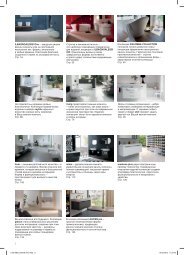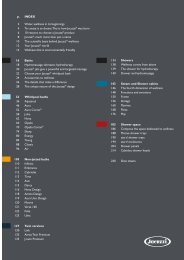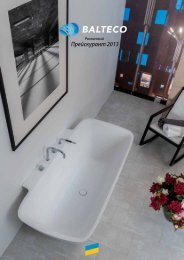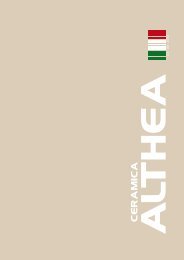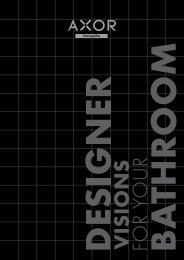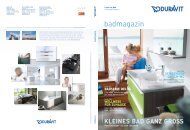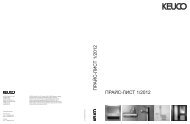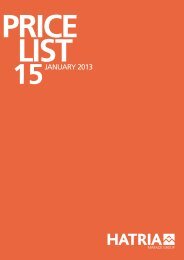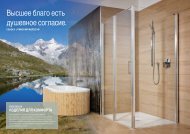Create successful ePaper yourself
Turn your PDF publications into a flip-book with our unique Google optimized e-Paper software.
RECOMMENDATIONS FOR INSTALLATION<br />
SELECTION OF THE INSTALLATION SYSTEM AND THE BONDING MATERIAL:<br />
In order to select the proper installation system and bonding material, the following tables must be consulted:<br />
TABLE “A” - POROUS TILES<br />
TABLE “B” - GLAZED STONEWARE TILES<br />
TABLE “C” - PORCELAIN TILES<br />
For each type of tile, these tables list the following data:<br />
- The surface to be tiled.<br />
- Tile size, whether it is larger or smaller than 35 x 35 cm.<br />
- Substrate type: floor or wall, in interior or exterior.<br />
These tables will enable us to determine the following:<br />
- The best suited installation system. If the thick-bed system proves suitable, then the thin-bed system may also be used; but the opposite is not the<br />
case.<br />
- The type(s) of recommended bonding materials.<br />
TABLA “A”<br />
POROUS TILES<br />
SURFACE TO BE<br />
TILED<br />
Ceramic brick or<br />
ceramic / concrete<br />
block<br />
Cement mortar<br />
base<br />
Elements with<br />
smooth concrete<br />
surfaces<br />
Plasterwork finish,<br />
moulding plaster<br />
panels<br />
Plasterboard<br />
panels<br />
Existing ceramic<br />
tiles, Terrazo or<br />
natural stone<br />
covering<br />
Wood<br />
TABLE “A” - POROUS TILES<br />
TILE SIZE<br />
CM<br />
< 35 x 35<br />
INSTALLATION<br />
SYSTEM<br />
Thick bed<br />
FLOOR COVERINGS WALL COVERING<br />
INTERIORS EXTERIORS INTERIORS EXTERIORS<br />
BONDING<br />
MATERIAL<br />
NOTE<br />
> 141<br />
BONDING<br />
MATERIAL<br />
NOTE<br />
BONDING<br />
MATERIAL<br />
NOTE<br />
BONDING<br />
MATERIAL<br />
Thin bed* Not Suitable<br />
C0, D, R C2<br />
NOTE<br />
MC 1<br />
> 35 x 35 Thin bed* C0, R 5 C2 5, 9<br />
< 35 x 35 Thin bed<br />
C0, D, R C2<br />
Not Suitable<br />
> 35 x 35 Thin bed C0, R 5 C2 5, 9<br />
< 35 x 35 Thin bed<br />
C1, D, R C2<br />
Not Suitable<br />
> 35 x 35 Thin bed C1, R 5 C2 5, 9<br />
< 35 x 35 Thin bed<br />
C1, D 6<br />
Not Suitable<br />
> 35 x 35 Thin bed C1 5, 6<br />
< 35 x 35 Thin bed<br />
C1, D<br />
Not Suitable<br />
> 35 x 35 Thin bed C1 5<br />
< 35 x 35 Thin bed<br />
(*) An intermediary insulating layer may be necessary<br />
NOTES:<br />
Not Suitable<br />
Not Suitable<br />
Not Suitable<br />
C2, D, R C2, R 5<br />
> 35 x 35 Thin bed C2, R 5 2<br />
< 35 x 35 Thin bed<br />
C1, D, R 6<br />
Not Suitable<br />
> 35 x 35 Thin bed 2<br />
Not Suitable<br />
(1) Thick-bed installation not suitable. As an alternative, lay a cement mortar base and install using the Thin-bed method (consult SURFACE TO BE TILED: Cement<br />
mortar base).<br />
(2) Wall tiles size incompatible with surface to be tiled. Reduce tile size (< 35 x 35 cm).<br />
(5) The floating and buttering method is recommended.<br />
(6) Apply a waterproofing primer first (In the case of using type C adhesives).<br />
(9) With tiles larger than 60 x 40 cm or equivalent surfaces and/or 40 kg/m2, use mechanical fastening elements.<br />
OBSERVATION:<br />
Cement-based adhesives, type C: The table indicates an enough type adhesive, but it can also be choosed a stronger one. For example, if the table indicates C0 as right<br />
one, the C1 and C2 types are also adecuated.



